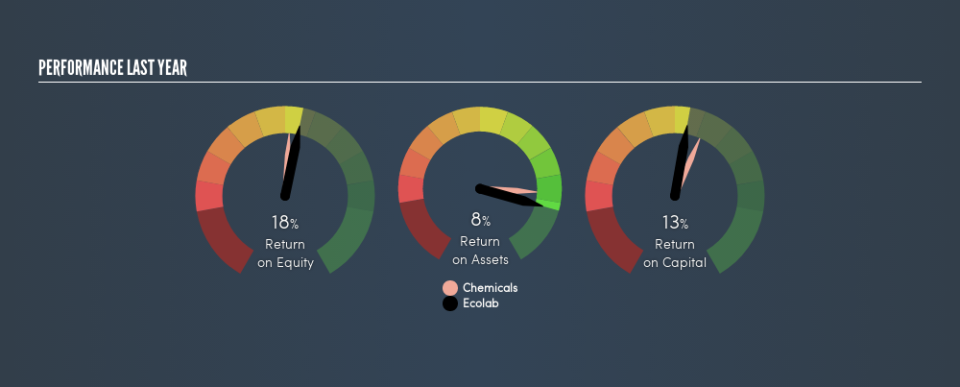Are Ecolab Inc.’s (NYSE:ECL) Returns On Investment Worth Your While?

Today we are going to look at Ecolab Inc. (NYSE:ECL) to see whether it might be an attractive investment prospect. To be precise, we’ll consider its Return On Capital Employed (ROCE), as that will inform our view of the quality of the business.
First up, we’ll look at what ROCE is and how we calculate it. Second, we’ll look at its ROCE compared to similar companies. Then we’ll determine how its current liabilities are affecting its ROCE.
What is Return On Capital Employed (ROCE)?
ROCE measures the amount of pre-tax profits a company can generate from the capital employed in its business. All else being equal, a better business will have a higher ROCE. In brief, it is a useful tool, but it is not without drawbacks. Author Edwin Whiting says to be careful when comparing the ROCE of different businesses, since ‘No two businesses are exactly alike.’
How Do You Calculate Return On Capital Employed?
The formula for calculating the return on capital employed is:
Return on Capital Employed = Earnings Before Interest and Tax (EBIT) ÷ (Total Assets – Current Liabilities)
Or for Ecolab:
0.13 = US$2.2b ÷ (US$20b – US$3.7b) (Based on the trailing twelve months to December 2018.)
So, Ecolab has an ROCE of 13%.
See our latest analysis for Ecolab
Does Ecolab Have A Good ROCE?
ROCE can be useful when making comparisons, such as between similar companies. We can see Ecolab’s ROCE is around the 12% average reported by the Chemicals industry. Regardless of where Ecolab sits next to its industry, its ROCE in absolute terms appears satisfactory, and this company could be worth a closer look.
When considering ROCE, bear in mind that it reflects the past and does not necessarily predict the future. ROCE can be deceptive for cyclical businesses, as returns can look incredible in boom times, and terribly low in downturns. This is because ROCE only looks at one year, instead of considering returns across a whole cycle. Future performance is what matters, and you can see analyst predictions in our free report on analyst forecasts for the company.
Do Ecolab’s Current Liabilities Skew Its ROCE?
Current liabilities are short term bills and invoices that need to be paid in 12 months or less. Due to the way the ROCE equation works, having large bills due in the near term can make it look as though a company has less capital employed, and thus a higher ROCE than usual. To counter this, investors can check if a company has high current liabilities relative to total assets.
Ecolab has total liabilities of US$3.7b and total assets of US$20b. Therefore its current liabilities are equivalent to approximately 18% of its total assets. A fairly low level of current liabilities is not influencing the ROCE too much.
Our Take On Ecolab’s ROCE
Overall, Ecolab has a decent ROCE and could be worthy of further research. Of course you might be able to find a better stock than Ecolab. So you may wish to see this free collection of other companies that have grown earnings strongly.
If you are like me, then you will not want to miss this free list of growing companies that insiders are buying.
We aim to bring you long-term focused research analysis driven by fundamental data. Note that our analysis may not factor in the latest price-sensitive company announcements or qualitative material.
If you spot an error that warrants correction, please contact the editor at editorial-team@simplywallst.com. This article by Simply Wall St is general in nature. It does not constitute a recommendation to buy or sell any stock, and does not take account of your objectives, or your financial situation. Simply Wall St has no position in the stocks mentioned. Thank you for reading.

